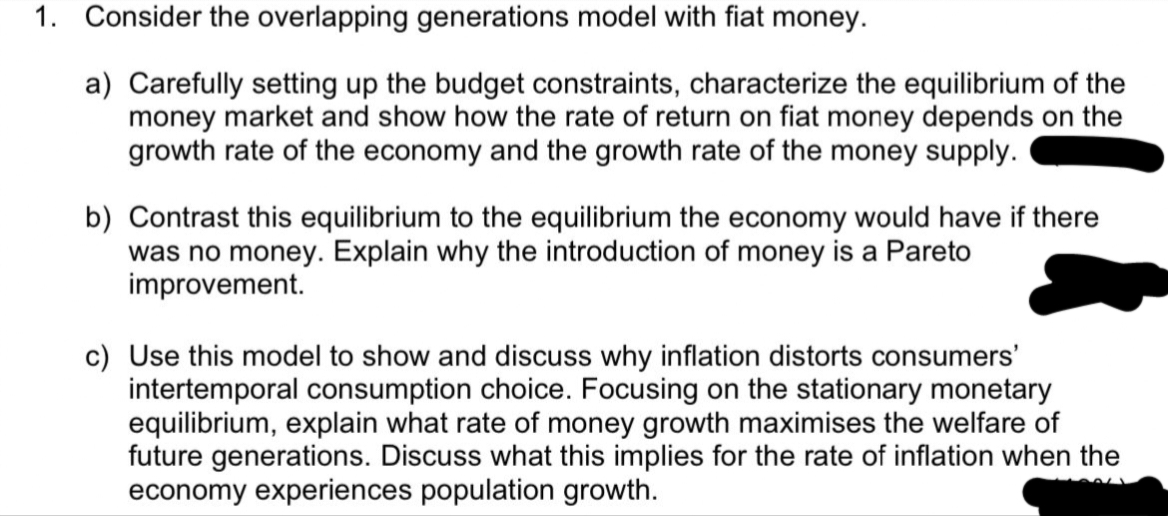1. Consider the overlapping generations model with fiat money. a) Carefully setting up the budget constraints, characterize the equilibrium of the money market and show how the rate of return on fiat money depends on the growth rate of the economy and the growth rate of the money supply. b) Contrast this equilibrium to the equilibrium the economy would have if there was no money. Explain why the introduction of money is a Pareto improvement. c) Use this model to show and discuss why inflation distorts consumers' intertemporal consumption choice. Focusing on the stationary monetary equilibrium, explain what rate of money growth maximises the welfare of future generations. Discuss what this implies for the rate of inflation when the
1. Consider the overlapping generations model with fiat money. a) Carefully setting up the budget constraints, characterize the equilibrium of the money market and show how the rate of return on fiat money depends on the growth rate of the economy and the growth rate of the money supply. b) Contrast this equilibrium to the equilibrium the economy would have if there was no money. Explain why the introduction of money is a Pareto improvement. c) Use this model to show and discuss why inflation distorts consumers' intertemporal consumption choice. Focusing on the stationary monetary equilibrium, explain what rate of money growth maximises the welfare of future generations. Discuss what this implies for the rate of inflation when the
Chapter15: Monetary Theory And Policy
Section: Chapter Questions
Problem 3.7P
Related questions
Question

Transcribed Image Text:1. Consider the overlapping generations model with fiat money.
a) Carefully setting up the budget constraints, characterize the equilibrium of the
money market and show how the rate of return on fiat money depends on the
growth rate of the economy and the growth rate of the money supply.
b) Contrast this equilibrium to the equilibrium the economy would have if there
was no money. Explain why the introduction of money is a Pareto
improvement.
c) Use this model to show and discuss why inflation distorts consumers'
intertemporal consumption choice. Focusing on the stationary monetary
equilibrium, explain what rate of money growth maximises the welfare of
future generations. Discuss what this implies for the rate of inflation when the
economy experiences population growth.
Expert Solution
This question has been solved!
Explore an expertly crafted, step-by-step solution for a thorough understanding of key concepts.
Step by step
Solved in 5 steps with 2 images

Knowledge Booster
Learn more about
Need a deep-dive on the concept behind this application? Look no further. Learn more about this topic, economics and related others by exploring similar questions and additional content below.Recommended textbooks for you


Macroeconomics: Private and Public Choice (MindTa…
Economics
ISBN:
9781305506756
Author:
James D. Gwartney, Richard L. Stroup, Russell S. Sobel, David A. Macpherson
Publisher:
Cengage Learning

Economics: Private and Public Choice (MindTap Cou…
Economics
ISBN:
9781305506725
Author:
James D. Gwartney, Richard L. Stroup, Russell S. Sobel, David A. Macpherson
Publisher:
Cengage Learning


Macroeconomics: Private and Public Choice (MindTa…
Economics
ISBN:
9781305506756
Author:
James D. Gwartney, Richard L. Stroup, Russell S. Sobel, David A. Macpherson
Publisher:
Cengage Learning

Economics: Private and Public Choice (MindTap Cou…
Economics
ISBN:
9781305506725
Author:
James D. Gwartney, Richard L. Stroup, Russell S. Sobel, David A. Macpherson
Publisher:
Cengage Learning

Principles of Economics 2e
Economics
ISBN:
9781947172364
Author:
Steven A. Greenlaw; David Shapiro
Publisher:
OpenStax

Exploring Economics
Economics
ISBN:
9781544336329
Author:
Robert L. Sexton
Publisher:
SAGE Publications, Inc

Economics (MindTap Course List)
Economics
ISBN:
9781337617383
Author:
Roger A. Arnold
Publisher:
Cengage Learning